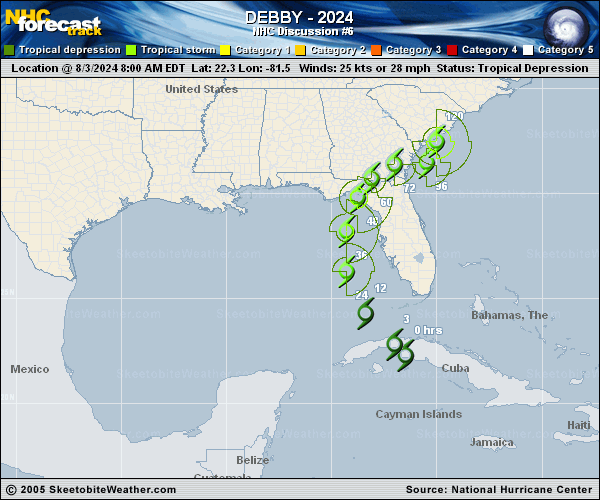
Official Discussion issued by the National Hurricane Center
Debby (AL042024) DATA RELEASED: 8/3/2024 9:00:00 PM UTC
|
Copy of official data Tropical Storm Debby Discussion Number 6 NWS National Hurricane Center Miami FL AL042024 500 PM EDT Sat Aug 03 2024 The tropical cyclone has become better organized since the last advisory, with the circulation center becoming better defined over the southeastern Gulf of Mexico and areas of outer convective banding to the north and south of the central region. A combination of earlier scatterometer data, surface observations in the Florida Keys, and ship reports in the Straits of Florida shows an area of 30-35 kt winds located about 120 n mi from the center in the eastern semicircle. Based on this information, Tropical Depression Four is upgraded to Tropical Storm Debby. The initial motion is now northwest or 310/13 kt. A large mid- to upper-level trough over the central United States is creating a break in the subtropical ridge, and Debby is expected to turn northward into this break in about 24 h. This should be followed by a gradual turn toward the northeast at a slower forward speed through 60 h. This motion should bring the center near or over the northern Gulf coast in roughly 48 h. After landfall, weakening steering currents should cause the cyclone to slow down while it moves northeastward or eastward over parts of northern Florida and Georgia. The uncertainty in the forecast increases significantly after 60 h as the cyclone interacts with a portion of the U.S. trough. The latest GFS and ECMWF models show a slow eastward motion into the Atlantic, followed by a turn toward the north or northwest that brings the center back inland. On the other hand, the Canadian model is still forecasting Debby to move slowly northeastward across the southeastern states and does not bring it over the Atlantic. This portion of the new forecast track continues to show a slow motion and leans toward the GFS/ECMWF solutions. Conditions are favorable for strengthening over the Gulf of Mexico with warm sea surface temperatures and light shear. Intensification is likely to be slow during the first 12-24 h, then proceed at a faster rate after the cyclone develops an organized inner core. The new intensity forecast calls for a peak intensity of 65 kt at landfall on the Gulf coast of Florida in best agreement with the HWRF model. Weakening is forecast after landfall while the system moves over the southeastern United States. Beyond 72 h, the intensity forecast remains quite uncertain due to the possibility of land interaction and how much interaction will occur with the aforementioned mid-latitude trough. Key Messages: 1. Heavy rainfall will likely result in considerable flash and urban flooding across portions of Florida and the coastal areas of the Southeast this weekend through Thursday. Significant river flooding is also expected. 2. Hurricane conditions are expected on Monday along portions of the Florida Big Bend region where a Hurricane Warning is in effect, with tropical storm conditions beginning late Sunday. Tropical storm conditions are expected through Monday farther south within the Tropical Storm Warning along Florida's west coast, including the Tampa Bay area and the Lower Florida Keys. 3. There is a danger of life-threatening storm surge inundation along portions of the Gulf coast of Florida from Aripeka to Indian Pass. Life-threatening storm surge is possible south of Aripeka to Bonita Beach, including Tampa Bay and Charlotte Harbor. 4. Impacts from storm surge, strong winds, and heavy rains are possible elsewhere in Florida and along the southeast coast of the United States from Georgia to North Carolina through the middle of next week, and interests in those areas should continue to monitor the progress of this system. Additional watches and warnings will likely be required tonight or on Sunday. FORECAST POSITIONS AND MAX WINDS INIT 03/2100Z 23.9N 83.2W 35 KT 40 MPH 12H 04/0600Z 25.3N 84.1W 40 KT 45 MPH 24H 04/1800Z 27.2N 84.6W 45 KT 50 MPH 36H 05/0600Z 28.9N 84.4W 55 KT 65 MPH 48H 05/1800Z 30.2N 83.8W 65 KT 75 MPH...INLAND 60H 06/0600Z 31.0N 83.0W 40 KT 45 MPH...INLAND 72H 06/1800Z 31.3N 82.0W 35 KT 40 MPH...INLAND 96H 07/1800Z 31.5N 80.5W 40 KT 45 MPH...OVER WATER 120H 08/1800Z 33.0N 80.4W 50 KT 60 MPH...INLAND $$ Forecaster Beven |